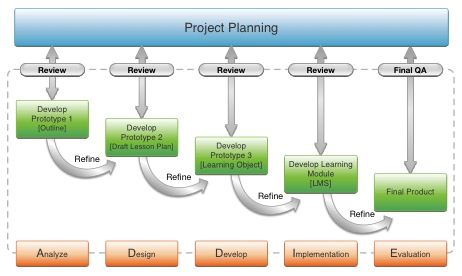Improving Online Training Programs: The Rapid Prototyping Model
By Jana Kooi
February 24, 2015
In response to student demand for flexibility, Florida State College at Jacksonville has developed a framework for developing programs that allow students to learn where and when they want.
Today’s community college students wear many hats: Whether a part-time employee, a parent or a midcareer worker looking to change fields, our students need flexibility in where and when they receive their education. This is where online training comes in.
The key to creating a successful online training program is to use an efficient, collaborative and consistent model for program development.
In response to the high demand for online training programs, not only from students but also from employers and state and local government agencies, Florida State College at Jacksonville (FSCJ) has designed a successful framework for online training program development: the Rapid Prototyping Model.
This model capitalizes on collaboration with a variety of professionals, each of whom contributes from their specific skill area (whether in visual design, drafting lesson plans or developing milestones and evaluation goals). A streamlined process of continual review and evaluation makes for the best and most efficient program development possible.
Success Story: Fresh for Florida Kids
The Fresh for Florida Kids Training Program is an online learning environment that provides training for Florida’s school nutrition professionals. Developed by FSCJ and the Florida Department of Agriculture and Consumer Services (FDACS), the training and education is specifically centered on the new national school lunch and breakfast standards and aims to train professionals for their current jobs as well as position them for career growth in their industry. The platform was created under the Rapid Prototyping Model, with FSCJ as project manager and FDACS as content contributor.
How to Do It: Rapid Prototyping Model
The key to success is frequent and timely feedback throughout the process. Team participation and the streamlined process improve the final design and reduce the need for changes after development.
Example: The Rapid Prototyping process applied to lesson-plan creation involves the following:
- Prototype Development: Create training topic outlines, draft lesson plans with audio scripts and assess plans based on learning outcomes and instructional materials.
- Review: Communicate any changes and approval.
- Refinement: Correct the lesson plans according to review feedback.
Each step in the program development follows the model in the same fashion, until development is complete. The Rapid Prototyping Model is depicted below.

With all stakeholders involved throughout the process, the opportunity for a successful project is maximized. Potential issues are identified and resolved sooner, increasing project efficiency and improving outcomes during design and development. This reduces the risk of expensive and untimely modifications after the process has been completed.
As online training becomes an essential part of the 21st-century student’s educational experience, it is our responsibility to create the online programs they need to reach success in their education and careers. This model will allow us to do so as efficiently and effectively as possible.






